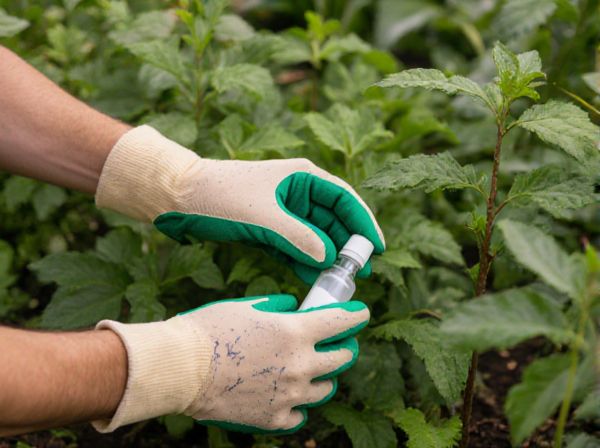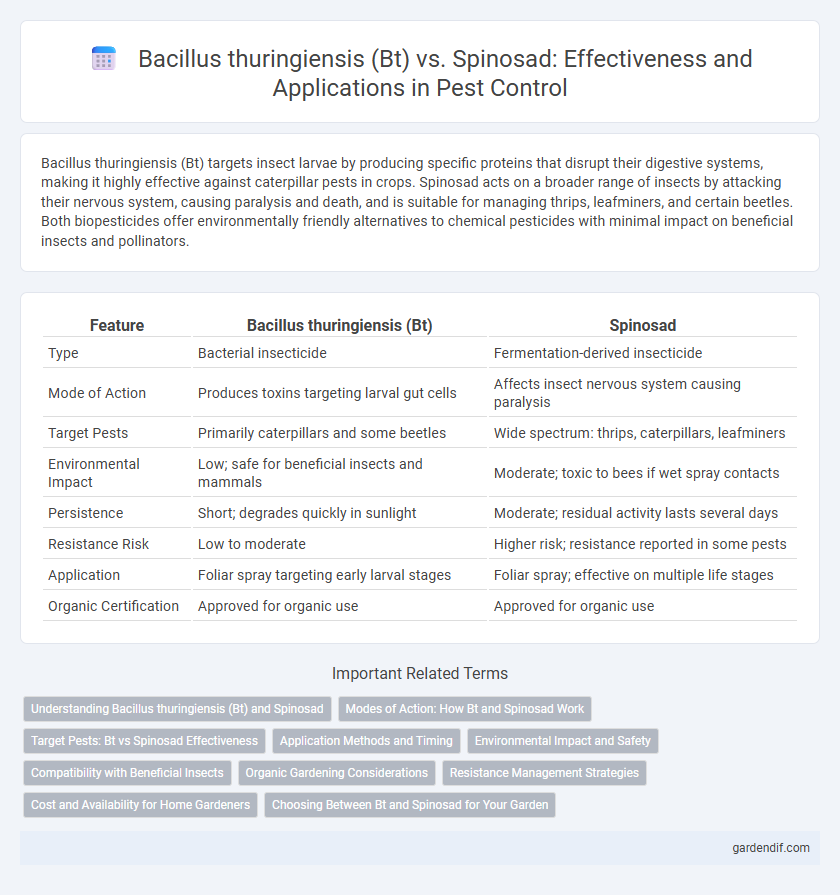
Bacillus thuringiensis (Bt) vs spinosad Illustration
Bacillus thuringiensis (Bt) targets insect larvae by producing specific proteins that disrupt their digestive systems, making it highly effective against caterpillar pests in crops. Spinosad acts on a broader range of insects by attacking their nervous system, causing paralysis and death, and is suitable for managing thrips, leafminers, and certain beetles. Both biopesticides offer environmentally friendly alternatives to chemical pesticides with minimal impact on beneficial insects and pollinators.
Table of Comparison
| Feature | Bacillus thuringiensis (Bt) | Spinosad |
|---|---|---|
| Type | Bacterial insecticide | Fermentation-derived insecticide |
| Mode of Action | Produces toxins targeting larval gut cells | Affects insect nervous system causing paralysis |
| Target Pests | Primarily caterpillars and some beetles | Wide spectrum: thrips, caterpillars, leafminers |
| Environmental Impact | Low; safe for beneficial insects and mammals | Moderate; toxic to bees if wet spray contacts |
| Persistence | Short; degrades quickly in sunlight | Moderate; residual activity lasts several days |
| Resistance Risk | Low to moderate | Higher risk; resistance reported in some pests |
| Application | Foliar spray targeting early larval stages | Foliar spray; effective on multiple life stages |
| Organic Certification | Approved for organic use | Approved for organic use |
Understanding Bacillus thuringiensis (Bt) and Spinosad
Bacillus thuringiensis (Bt) is a naturally occurring soil bacterium that produces toxins targeting specific insect larvae, making it an effective biological pesticide against pests like caterpillars, beetles, and mosquitoes. Spinosad, derived from the fermentation of Saccharopolyspora spinosa, acts on the nervous system of insects causing paralysis and death, showing broad-spectrum efficacy against thrips, leafminers, and certain caterpillars. Both Bt and Spinosad are valued for their low toxicity to beneficial insects and environmental safety, offering sustainable alternatives to chemical pesticides in integrated pest management programs.
Modes of Action: How Bt and Spinosad Work
Bacillus thuringiensis (Bt) functions by producing crystal proteins toxic to specific insect larvae, which disrupt the gut lining upon ingestion, leading to larval death. Spinosad targets the insect nervous system by acting on nicotinic acetylcholine receptors and GABA receptors, causing rapid paralysis and mortality. These distinct modes of action make Bt effective primarily against Lepidoptera larvae, while spinosad controls a broader range of pests including thrips, leafminers, and fruit flies.
Target Pests: Bt vs Spinosad Effectiveness
Bacillus thuringiensis (Bt) exhibits high effectiveness against Lepidopteran larvae such as caterpillars and moths by producing specific toxins that disrupt their gut cells, while spinosad targets a broader spectrum including Lepidoptera, Diptera, and thrips through neural disruption. Bt remains preferred for organic farming due to its narrow spectrum and minimal impact on beneficial insects, whereas spinosad offers rapid knockdown and residual control but may affect non-target species. Pest management strategies often integrate Bt for early infestation control and spinosad for resistant or heavy infestations, optimizing overall pest suppression.
Application Methods and Timing
Bacillus thuringiensis (Bt) is commonly applied as a foliar spray targeting early larval stages of lepidopteran pests, with optimal timing during the hatching phase for maximum ingestion and effectiveness. Spinosad applications are versatile, effective for both foliar sprays and soil treatments, and should be timed to coincide with the presence of young insect larvae to ensure rapid contact and ingestion, enhancing control of thrips, leafminers, and caterpillars. Both Bt and spinosad require precise monitoring of pest life cycles to optimize application timing and maximize pest mortality while minimizing non-target impacts.
Environmental Impact and Safety
Bacillus thuringiensis (Bt) offers targeted pest control with minimal impact on non-target organisms and is widely regarded as environmentally safe due to its specificity to certain insect larvae. Spinosad, derived from natural soil bacteria, provides broad-spectrum pest control but exhibits slightly higher toxicity to beneficial insects like pollinators and aquatic invertebrates. Both agents break down rapidly in the environment, yet Bt is often preferred for integrated pest management where environmental safety is a priority.
Compatibility with Beneficial Insects
Bacillus thuringiensis (Bt) demonstrates high compatibility with beneficial insects due to its targeted mode of action against specific pest larvae, minimizing non-target impacts. Spinosad, although effective against a broad spectrum of pests, exhibits some toxicity to certain pollinators and predatory insects, necessitating careful application timing to reduce harm. Studies indicate Bt's selective toxicity preserves beneficial insect populations better, making it a preferred choice in integrated pest management programs focused on ecological balance.
Organic Gardening Considerations
Bacillus thuringiensis (Bt) and spinosad are both effective organic pesticides commonly used in organic gardening to control a variety of insect pests such as caterpillars and thrips. Bt is a naturally occurring soil bacterium that produces proteins toxic to specific insect larvae, making it highly selective and environmentally safe with minimal impact on beneficial insects and humans. Spinosad, derived from the fermentation of Saccharopolyspora spinosa, offers broad-spectrum pest control and rapid knockdown but may pose higher risks to pollinators if not applied carefully, requiring judicious use within organic management practices.
Resistance Management Strategies
Bacillus thuringiensis (Bt) and spinosad are key biopesticides used in resistance management strategies to control insect pests while reducing chemical pesticide reliance. Bt toxins target specific insect gut receptors, promoting selective pest control and delaying resistance through gene pyramiding and crop rotation, whereas spinosad acts on insect nervous systems with distinct modes of action, supporting resistance management by alternating or mixing treatments. Integrating Bt and spinosad within integrated pest management frameworks effectively mitigates resistance development by leveraging their complementary mechanisms and maintaining pest susceptibility.
Cost and Availability for Home Gardeners
Bacillus thuringiensis (Bt) is widely available in garden centers and online at a relatively low cost, making it an accessible option for home gardeners seeking an organic pest control method. Spinosad, while also effective against a range of pests, tends to be more expensive and less widely stocked in smaller retail outlets. Both products offer organic certification, but Bt's affordability and broader availability enhance its practicality for home gardening applications.
Choosing Between Bt and Spinosad for Your Garden
Bacillus thuringiensis (Bt) targets specific caterpillar pests by producing toxins that disrupt their digestive systems, making it ideal for controlling lepidopteran larvae with minimal impact on beneficial insects. Spinosad, derived from bacterial fermentation, offers a broader spectrum of control against thrips, leafminers, and caterpillars, and acts through neurotoxicity causing rapid paralysis. Choosing between Bt and spinosad depends on pest type and resistance management, with Bt preferred for caterpillars due to its specificity and reduced environmental impact, while spinosad suits mixed infestations requiring faster knockdown.
Bacillus thuringiensis (Bt) vs spinosad Infographic

 gardendif.com
gardendif.com